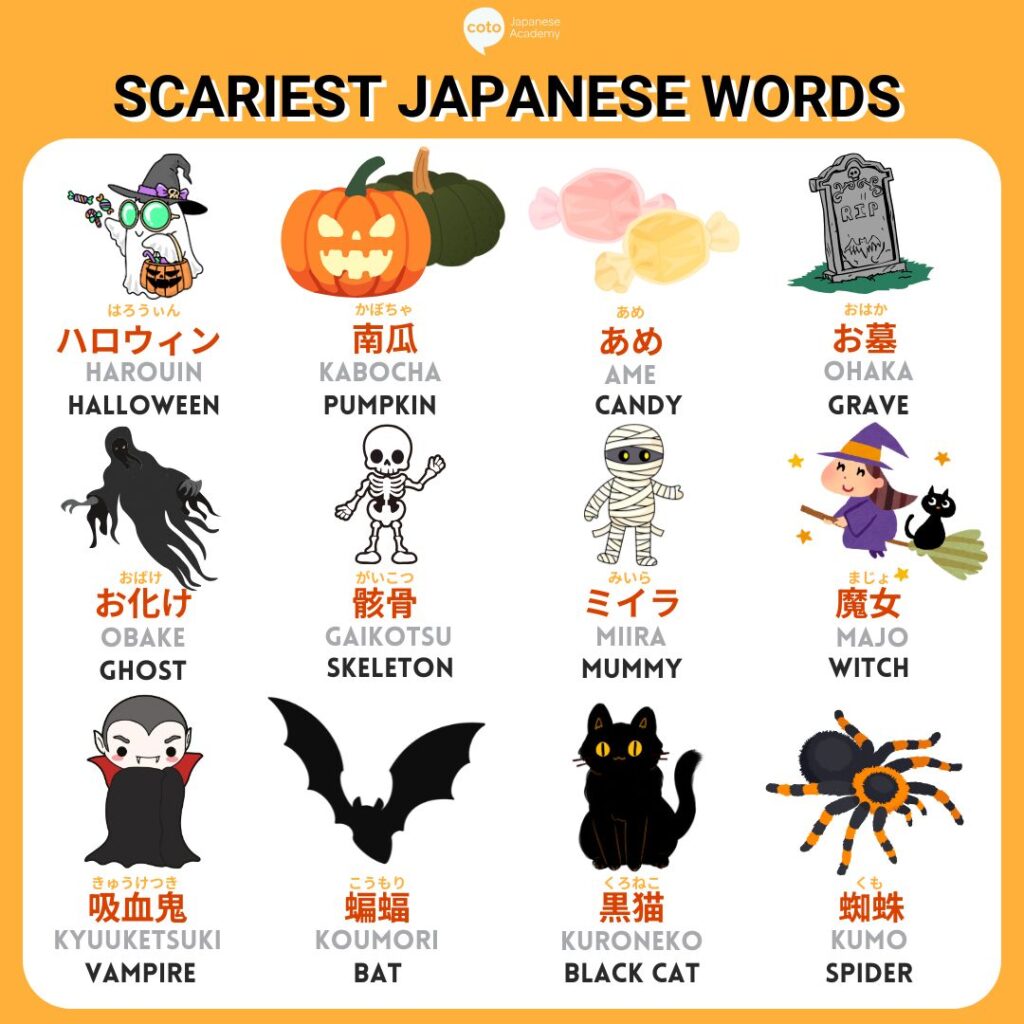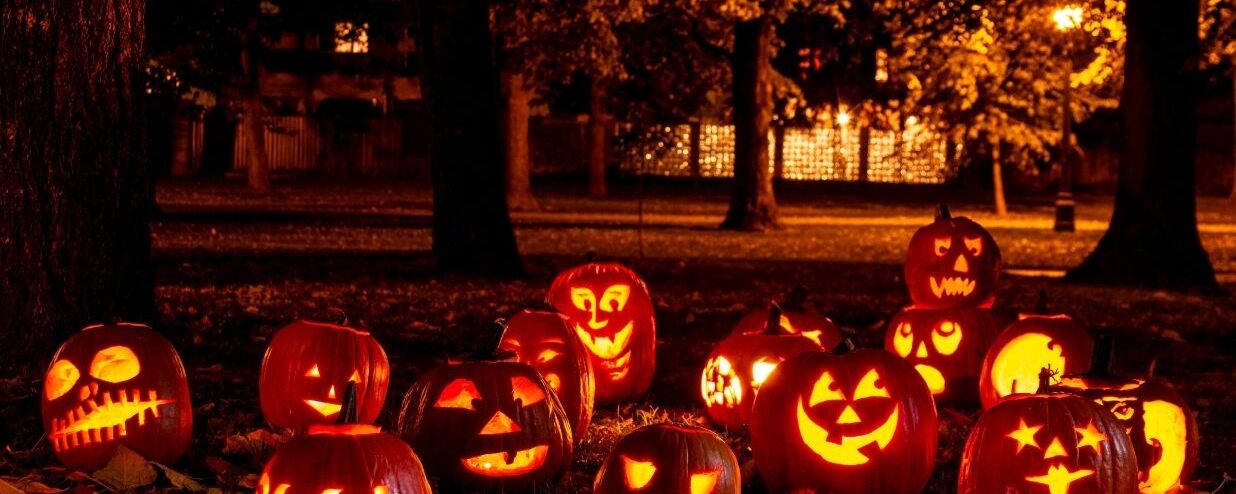Halloween in Japan is just around the corner, and when is better time to learn some Japanese Halloween vocabulary, if not now? How else can you describe some of the ghosts, monsters, and creepy crawlers that will spring up across the nation? Japan is no stranger to celebrating various occasions, and Halloween is quickly gaining popularity, with Halloween-themed events and house parties becoming increasingly widespread.
People don’t just dress up in costumes and show up to different Halloween events in Tokyo. If you’re planning to parade around the city, it helps to know some Halloween-themed Japanese words, whether you want to describe your own costume or comment on someone else’s.
So, what are some key terms to know and look out for to make the most out of Halloween in Japan? Read more to find out!
Is Halloween Celebrated in Japan? Is it Different From the U.S.?
Halloween is becoming increasingly popular in Japan, especially in larger cities such as Tokyo, Osaka, and Kyoto. However, unlike in the U.S., Halloween in Japan is more focused on public festivities than on trick-or-treating at homes.
The spooky season is particularly popular among young people, thanks to its fun supernatural themes and the opportunity to wear costumes. Large costume events, such as the one in Ikebukuro, often focus on character cosplays from Japanese video games and anime.
While Japan hosts many cosplay-focused events, Halloween costumes in Japan and the U.S. share similarities. People in both countries enjoy dressing up as characters from movies, pop culture, and even Japanese media, so in terms of costumes, Halloween isn’t too different between the two countries.
The biggest difference is trick-or-treating, which has not caught on in Japan as much as costume events. Small-scale trick-or-treat activities may occur at elementary schools or locally organized events, but generally, only young children participate rather than entire neighborhoods or cities.
20 Scary Japanese Words About Halloween

1. ハロウィン (Harouin): Halloween
First up, the basic Halloween vocabulary in Japanese. Let’s take a look at the word ハロウィン (Harowin). Want to guess what it means? You’ve probably already guessed it by looking at the romaji, haven’t you? Well, for those who are still trying to figure it out, it actually means Halloween. Written in Katakana, it is more or less a direct translation from the English Word “Halloween” itself.
2. 南瓜 (Kabocha): Pumpkin
Of course, we cannot write about Japanese Halloween vocabulary without including pumpkin. Pumpkin, or 南瓜 (kabocha), is often written in hiragana as かぼちゃ instead of kanji. Kabocha translates to pumpkin or winter squash, and is one of the most popular autumn flavors in Japan.
The term also describes the Japanese variety of pumpkin that has a deep, dark green outside and an orange-colored flesh on the inside. The texture is soft and smooth, and the flavor is somewhat sweet with nutty notes. The fruit (fun fact: kabocha is botanically a fruit) is commonly used in Japanese cuisine, especially when it’s in season, which is around autumn and winter. You can find it in tempura, nabe, and a variety of other popular dishes.
So, to conclude, the word kabocha covers both the western and Japanese pumpkin. This term can describe the iconic Halloween pumpkin monster and the winter squash found in Japanese cuisine.
3. あめ (Ame): Candy
あめ is the word for candy, generally referring to the hard candies derived from sugars and starches such as rice, cornstarch, or potatoes. For a more general term encompassing all varieties of candy, such as chocolate, nougats, and caramels, you can say キァンディー (kiandii).
4. お墓 (Ohaka): Grave
お墓 (おはか), or ohaka, refers to the Japanese grave or tombstone. Japanese tombs look physically different compared to Western graves, but they play a similar role as a physical structure representing an ancestor or loved one being laid to rest.
While graves might be a common prop in Halloween decorations, in Japan, the Obon festival (which takes place in August) is when Japanese people visit family graves, which is known as お墓参り(ohaka mairi)
5. お化け (Obake): Ghost
お化け (obake) refers to ghosts or paranormal beings in general. The term obake comes from the term 化ける (bakeru), which means to transform. The term is similar to 化け物 (bakemono), which broadly refers to creatures that transform; one famous example is the kitsune, or shape-shifting fox, found in Japanese folklore.
The term now generally describes ghosts similar to yuurei (which we will describe next), as well as the paranormal, such as its usage in お化け屋敷 (obake yashiki) or haunted house. Obake yashiki are a popular activity in many theme parks, so be sure to visit one this Halloween!
6. 幽霊 (Yuurei): Spirit
幽霊 (ゆうれい), or Yuurei, refers to Japanese ghosts or spirits found throughout Japanese folklore. They are generally restless spirits who are tied to the world due to strong unresolved emotions, but are not necessarily dangerous. For example, they can be stuck in the world due to their love for their child and remain to watch over them like an invisible guardian.
Yuurei, who have strong emotions of anger or hatred, known as 怨霊 (onryou), meaning vengeful spirits, are very dangerous. So, be careful not to come across an onryou this Halloween!
7. 骸骨 (Gaikotsu): Skeleton
Another in our Japanese Halloween vocabulary list is gaikotsu. Gaikotsu refers to skeletons, usually human ones. This word generally describes the whole skeletal body of a human. To describe the skull, you can use the word 頭蓋骨 (zugai kotsu).
8. ミイラ (Miira): Mummy
You might think that the Japanese word for mummy is a literal loanword: maami. But for this preserved body, the Japanese language uses the Portuguese word mirra (myrrh). This is because miira refers to mummies wrapped in bandages, just like in horror movies. You’ll often see them in haunted houses (お化け屋敷, or obake yashiki) during Halloween events.
Check out other Japanese loanwords that don’t come from English.
9. 悪魔 (Akuma): Demon or Devil
You are probably thinking of Akuma from the video game, Street Fighter. But they got the name of the character from an ancient Japanese term for devil or demon. The word can be traced back to Buddhist texts from around 700 AD. The character 悪 (aku) translates to “evil” or “bad” and 魔 (ma) just refers to the devil, so the literal meaning is “evil devil”. You really can’t find a more evil entity than Akuma.
10. 魔女 (Majo): Witch
Ma (魔) means demon or evil spirit, and jo (女) means woman. Together, 魔女 means witch. In Japanese culture, witches can appear as either frightening villains or magical heroines, depending on the story. Think of Studio Ghibli’s Kiki’s Delivery Service, which in Japanese is 魔女の宅急便 (Majo no Takkyubin), translating literally to witch delivery service.
In Japan, witches are not always represented as evil or malevolent; instead, they can be good-spirited people who have magical abilities.
Can you learn Japanese from anime like Kiki’s Delivery Service? To find out, read our blog on Learning Japanese with Anime!
11. 吸血鬼 (Kyuuketsutki): Vampire
Literally “blood-sucking demon.” 吸 (kyuu) means “to suck,” 血 (ketsu or chi) means “blood,” and 鬼 (ki or oni) means “demon.” Much like in the West, in Japanese media, vampires can be both terrifying and romanticized.
12. こうもり (Koumori): Bat
Often associated with darkness, caves, and vampires. While not inherently scary in Japanese culture, bats take on a spooky vibe during Halloween. This more scary image of the bat was adopted along with the Halloween holiday from the West.
13. 黒猫 (Kuroneko): Black Cat
In Japan, black cats have mixed symbolism. They can bring bad luck (like in the West) but are also considered good luck for single women, believed to help attract suitors. On Halloween, they’re more on the spooky side.
14. クモ (Kumo): Spider
Spiders are associated with fear and creepiness, especially their webs in haunted settings. In folklore, there’s even the Jorougumo (絡新婦), a spider woman who lures men to their doom.
15. ドキドキ(Doki doki): Heart Beating
Similarly, ドキドキ (Doki-Doki) is the onomatopoeia for a beating heart and actually has a wide range of uses in Japanese. It can be used to indicate excitement, nervousness, or as a way of expressing fear.
怖い(こわい)、心臓(しんぞう)がドキドキしちゃうよ!
Kowai, shinzou ga doki-doki shichau yo!
That’s scary, my heart is beating so fast right now.
16. 怒り(Ikari) – Anger or Hatred
The word 怒り(Ikari) can be used to express the anger and hatred that someone holds towards another individual. This word conveys intense anger or wrath. In Japanese folklore and horror, 怨霊 (onryou), which we described earlier, comes from the word 怒り(ikari) or anger and 霊(ryou/rei) or spirit. So, together the term means angry spirit.
17. 呪い (Noroi): Curse
Spells, hexes, and dark magic are all noroi. In Japanese horror, cursed objects, or noroi no ningyou (呪いの人形), and cursed videos, or noroi no bideo (呪いのビデオ), are common scary themes.
18. びっくり(Bikkuri): Surprised
Not always negative, but in a scary setting, it’s the sudden shock or jump-scare feeling. You can say びっくりした!, or “That scared me!” when surprised by a jump-scare from a horror movie or haunted house. Alternatively, you can also say the slang form, びびる (bibiru).
19. 不気味 (Bukimi): Eerie or Creepy
Not necessarily a Halloween-themed Japanese vocabulary, bukimi describes something unsettling, eerie, or unnerving, like an abandoned house at night or a creepy doll staring at you. Perfect Halloween atmosphere.
20怖い (Kowai): Scared
怖い (kowai) is an essential Japanese adjective for scary, usually as a way of expressing that something looks or is scary. For example, you can say “ホラー映画が怖いです”(horaa eiga ga kowai desu) or “horror movies are scary”. However, a common pitfall beginners make is when they say “私は怖い” (watashi wa kowai), which means “I am scary.” To say that “I am scared,” you must say, “私は怖がっている” (watashi wa kowagattiru).
Alternatively, the word 恐怖 (kyoufu) can also be used to express your fears and dread for something.
Expand Your Emotions With Japanese Halloween Words
Learning Halloween vocabulary in Japanese is not just about memorizing words; it’s about exploring how Japan interprets fear, the supernatural, and the mysterious. They are not just useful in Halloween but in expressing yourself in Japanese overall. Plus, don’t miss out on trying kabocha and ame, or candy.
To get the most out of this list of words, try practicing them with a professional teacher who can guide and train you to use them in natural, everyday conversation.
Why not join Japanese lessons at Coto Academy? Our classes are designed to help you engage with real, authentic Japanese culture.
We offer intensive Japanese courses as well as part-time options, so whether you want to immerse yourself fully or fit lessons into a busy schedule, there’s something for you. Start your journey to speaking Japanese confidently today!
Why join Coto Academy?
- Professional, native Japanese teachers
- Over 60+ different Japanese classes over 18 levels
- Small classroom of only up to 8 students for personalized support
Fill out the form below for a free level check and consultation.
FAQ
Is Halloween popular in Japan?
Yes! Halloween has grown rapidly in Japan, especially in cities like Tokyo. It’s more about costumes, parties, and decorations than trick-or-treating, but spooky words definitely add to the fun.
What is the word for candy in Japanese?
Candy can either be あめ (ame), which generally describes Japanese hard candy, or キャンディー (kyandii), which refers to all varieties of candy in general.
Are there Japanese monsters or yokai tied to Halloween?
While Halloween in Japan borrows heavily from Western imagery (witches, vampires, bats), you’ll also find yokai like Jorougumo (the spider woman) or yurei (ghosts) being used in Halloween-themed events.
What are some Halloween Japanese vocabulary I should know about?
Some key Japanese Halloween vocabulary includes おばけ (obake, ghost), かぼちゃ (kabocha, pumpkin), こうもり (koumori, bat), ゾンビ (zonbi, zombie), and ハロウィン (Harowin, Halloween).
Want to expand your vocabulary beyond just Halloween-related Japanese vocabulary? You might want to check out:
